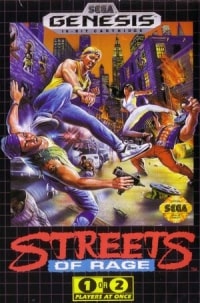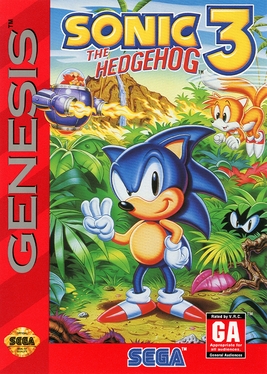
Sonic the Hedgehog 3 is a 1994 platform game developed and published by Sega for the Genesis. Like previous Sonic games, players traverse side-scrolling levels while collecting rings and defeating enemies. They control Sonic and Tails, who attempt to retrieve the Chaos Emeralds to stop the evil Doctor Robotnik from relaunching his space station, the Death Egg, after it crash-lands on a mysterious floating island. Sonic 3 introduces Knuckles the Echidna, the island guardian, who lays traps for Sonic and Tails.

Sonic the Hedgehog is a 1991 platform game developed by Sonic Team and published by Sega for the Genesis/Mega Drive. It was released in North America on June 23 and in PAL regions and Japan the following month. Players control Sonic the Hedgehog, who can run at near supersonic speeds; Sonic sets out on a quest to defeat Dr. Robotnik, a scientist who has imprisoned animals in robots and seeks the powerful Chaos Emeralds. The gameplay involves collecting rings as a form of health, and a simple control scheme, with jumping and attacking controlled by a single button.

Sonic the Hedgehog is a 1991 side-scrolling platform game. It is a companion to the 16-bit Sega Genesis game Sonic the Hedgehog for the 8-bit Master System and Game Gear consoles. Ancient—a studio founded by composer Yuzo Koshiro for the project—developed the game and Sega published it to promote the handheld Game Gear. The 8-bit Sonic is a side-scrolling video game similar in style to the 16-bit game, but reduced in complexity to fit the 8-bit systems.
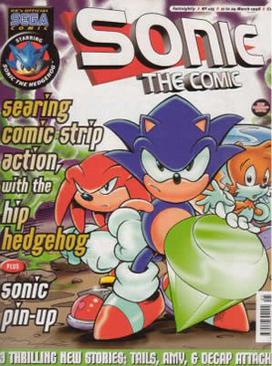
Sonic the Comic was a British children's comic published by Fleetway Editions between 1993 and 2002. It was the UK's Sega comic, featuring stories about its mascot Sonic the Hedgehog and related characters, as well as comic strips based on other Sega video games, along with news, reviews, and tips for games released for Sega systems.
In video game parlance, a multicart is a cartridge that contains more than one game. Typically, the separate games are available individually for purchase or were previously available individually. For this reason, collections, anthologies, and compilations are considered multicarts. The desirability of the multicart to consumers is that it provides better value, greater convenience, and more portability than the separate games would provide. The advantage to developers is that it allows two or more smaller games to be sold together for the price of one larger game, and provides an opportunity to repackage and sell older games one more time, often with little or no changes.

The Revenge of Shinobi, released in Japan as The Super Shinobi, is a hack-and-slash action video game developed and published by Sega in 1989. It was the first Shinobi game developed for the Sega Genesis, and was later released on the coin-operated version of that console, the Mega-Tech.
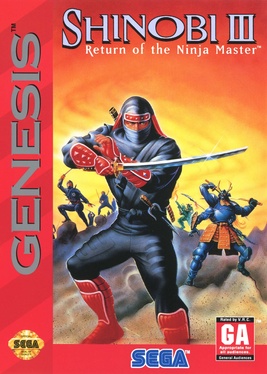
Shinobi III: Return of the Ninja Master, released in Japan as The Super Shinobi II, is a 1993 hack-and-slash platform game developed and published by Sega for the Mega Drive/Genesis. It is the direct sequel to the previous The Revenge of Shinobi. The game was intended to be released in 1992 and to be very different from the final version of the game in terms of levels and storyline.

Yuzo Koshiro is a Japanese composer and sound programmer. He is often regarded as one of the most influential innovators in chiptune and video game music, producing music in a number of genres including rock, jazz, symphonic, and various electronic genres such as house, electro, techno, trance, and hip hop.

Sega Classics Arcade Collection is the name of two compilations released for the Sega CD. Despite their titles, both versions of Sega Classics Arcade Collection include only the Sega Genesis ports of all the games included.

Streets of Rage 3 is a side-scrolling beat 'em up developed and published by Sega in 1994 for the Genesis. It is the third installment of the Streets of Rage series and the last game in the original trilogy. The game includes several changes over Streets of Rage and Streets of Rage 2, such as a more complex plot, inclusion of character dialog, longer levels, more in-depth scenarios and faster gameplay. Weapons can be integrated with unique moves with certain characters, hidden characters were added, and a few cutscenes were included to give the story greater depth.

Streets of Rage 2, known as Bare Knuckle II In Japan, is a 1992 side-scrolling beat 'em up video game published by Sega for the Mega Drive/Genesis. A sequel to Streets of Rage (1991), the characters Axel Stone and Blaze Fielding return while the game also introduces two new characters: Max Thunder, and Eddie "Skate" Hunter, the younger brother of Adam Hunter from the first game.

Shinobi is a series of hack-and-slash action video games created by Sega. The ninja (shinobi) Joe Musashi is the protagonist of the original series of games. The first Shinobi was released in 1987 as an arcade video game. Along with Alex Kidd and Sonic the Hedgehog, Joe Musashi has long been one of Sega's flagship characters, acting as a mascot for a short time in the late 1980s when ninjas were popular in mainstream media. The series' games are a showcase of Sega's technical accomplishment, noted for their high quality of graphics, gameplay and music, as well as their high level of difficulty. The Shinobi franchise sold more than 4.60 million copies.

Sonic the Hedgehog 2 is a 1992 platform game developed by Sega Technical Institute (STI) for the Sega Genesis. Players control Sonic as he attempts to stop Doctor Robotnik from stealing the Chaos Emeralds to power his space station. Like the first Sonic the Hedgehog (1991), players traverse side-scrolling levels at high speeds while collecting rings, defeating enemies, and fighting bosses. Sonic 2 introduces Sonic's sidekick Miles "Tails" Prower and features faster gameplay, larger levels, a multiplayer mode, and special stages featuring pre-rendered 3D graphics.
Streets of Rage is a series of side-scrolling beat 'em up video games, centering on the efforts of several ex-police vigilantes trying to rid a fictional American metropolis of Wood Oak City from a crime syndicate that has corrupted its local government. The first three games in the franchise were developed and published by Sega for the Sega Genesis in the early 1990s and have since been ported and re-released on various platforms. A fourth entry was released in 2020.

The music of the Streets of Rage series of beat 'em up games, released in the early 1990s, was produced by Yuzo Koshiro.
Ancient Corp. is a Japanese video game developer founded by composer Yuzo Koshiro and his mother and sister on April 1, 1990. The company has worked on games such as the 8-bit version of Sonic the Hedgehog, Streets of Rage 2, Beyond Oasis, Shenmue, and Gotta Protectors, among others.

Sonic's Ultimate Genesis Collection is a compilation of video games developed by Backbone Entertainment and published by Sega for PlayStation 3 and Xbox 360. The compilation features 48 Sega games which were previously released for the Sega Genesis, arcades and the Master System. It is the sequel to the Sega Genesis Collection released previously for the PlayStation 2 and PlayStation Portable, but contains 16 more games.

Sega Genesis Classics is a series of compilations featuring Sega Genesis video games released for Windows, Linux, macOS, PlayStation 4, Xbox One and Nintendo Switch. The collections are split into "Volumes", with the first four receiving both physical and digital releases and the fifth volume only being digitally released.

Streets of Rage 4 is a side-scrolling beat 'em up game developed by Dotemu, Lizardcube, and Guard Crush Games and published by Dotemu. The game is a continuation of Sega's Streets of Rage trilogy, originally released for the Sega Genesis during the 1990s. It was released for Nintendo Switch, PlayStation 4, Windows, Xbox One, Linux, and macOS, in 2020, for Stadia in 2021, and Android and iOS in 2022. Streets of Rage 4 received generally positive reviews and sold over 2.5 million copies by April 2021. An expansion, Mr. X Nightmare, was released in July 2021.
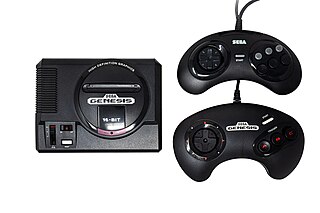
The Sega Genesis Mini, known as the Mega Drive Mini in regions outside of North America, is a dedicated console modeled on the Sega Genesis. The Mini emulates the original console's 16-bit hardware, and includes 42 games made available through emulation software by M2. It was released in North America and Japan in September 2019 and in Europe and the Middle East in October 2019. A follow-up, Sega Genesis Mini 2, was released in October 2022 and includes 60 games from the Genesis and Sega CD.
